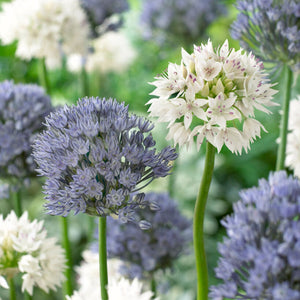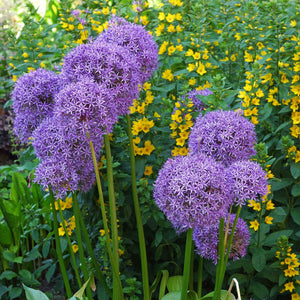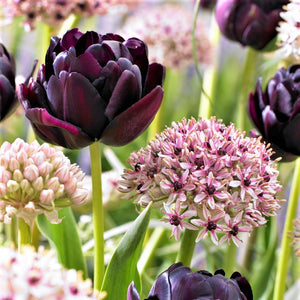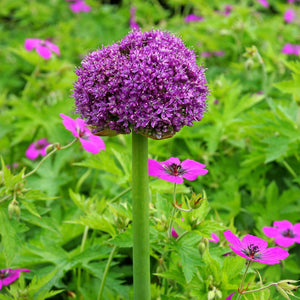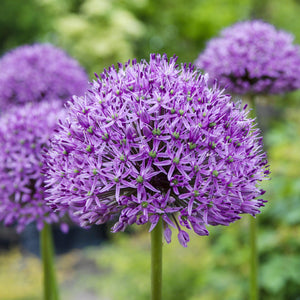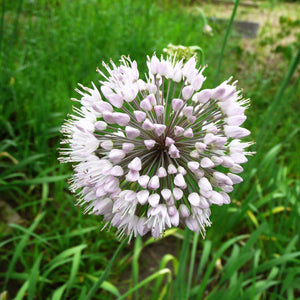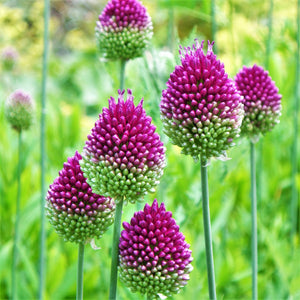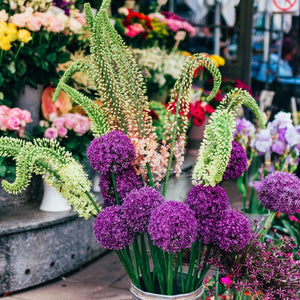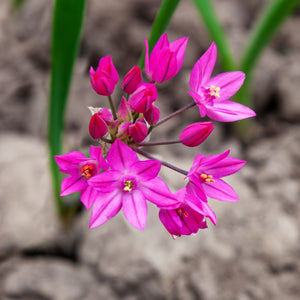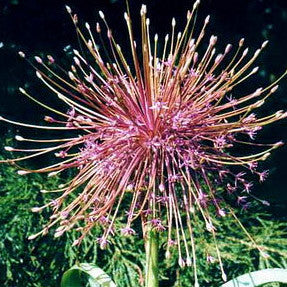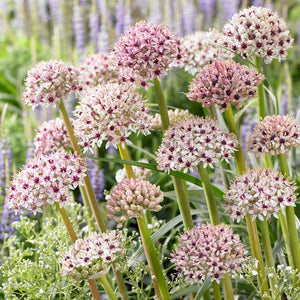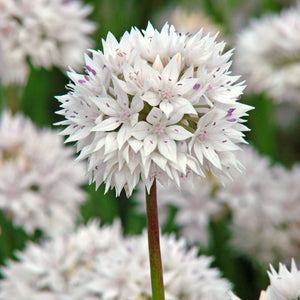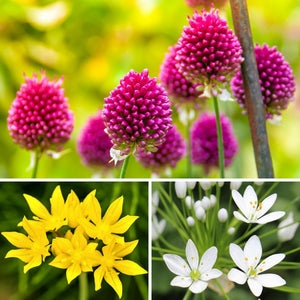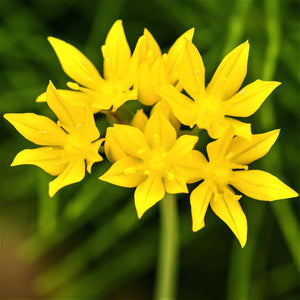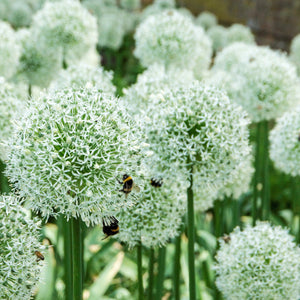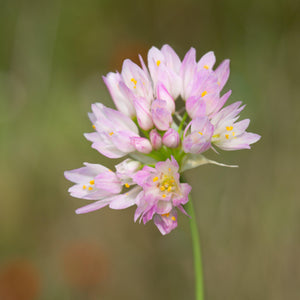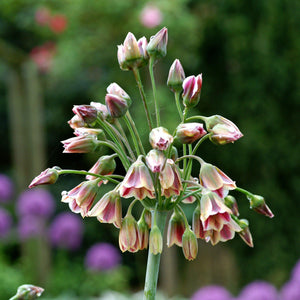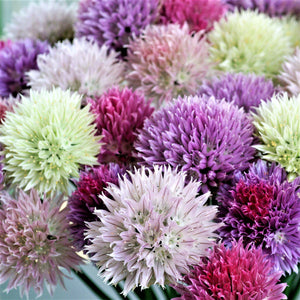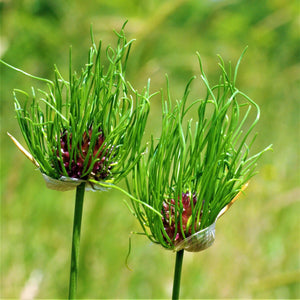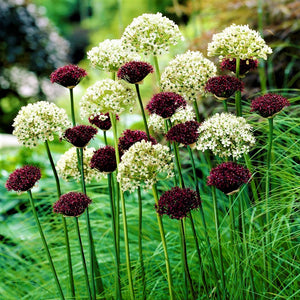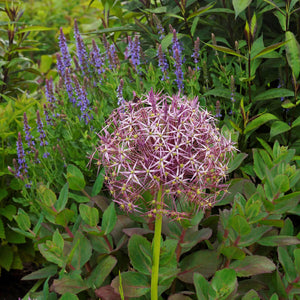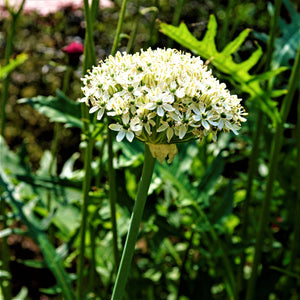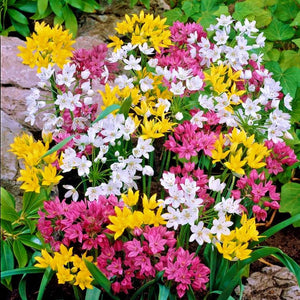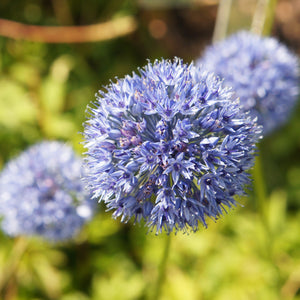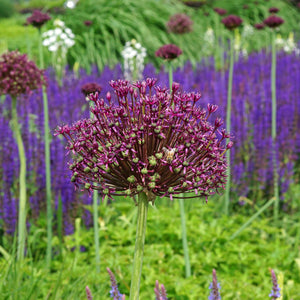- Home
- Planting Guides
- Allium Planting & Growing Guide
Allium Planting & Growing Guide
If you don't already consider onions to be gorgeous garden additions, we're about to change your mind with these ornamental balls of joy! As with garlic and onions, Alliums display round flower heads, and while they may not spice up your cooking, they do exhibit a subtle onion-like aroma when crushed. Each spherical cluster comprises dozens of striking, star-shaped florets that are sure to brighten your garden. They are remarkably tough plants—excellent for cutting, attractive to pollinators, and resistant to drought, cold, and rodents. Blooming from late spring to early summer, these fluffy globes range in height from 12" up to 4' with some blossoms being as large as soccer balls. Take your garden to the next level of dramatic design with gorgeous Alliums!
Success Snapshot
PLANTING
DEPTH
Species dependent; 4-8"

WATER
QUANTITY
Moderate to Low
SUNLIGHT
QUANTITY
Full Sun
PLANTING
PROXIMITY
6-8" Apart
BLOOM
SEASON
Late Spring - Summer
HARDINESS
ZONES
Species Dependent
Shop Related Products

Allium - Ocean Magic Mix
$8.95
Contains: 60 Allium bulbs, mixed blue and white
Botanical Name: Allium
Exposure: Full Sun
Hardiness: Zones 4-9

Allium - Globemaster
$21.95
Contains: 3 Allium Globemaster bulbs
Botanical Name: Allium globemaster
Exposure: Full Sun
Hardiness: Zones 5-9

Allium & Tulip - Beauty & Sparkle Blend
$14.95
Contains: 1 pack of 3 Allium bulbs and 1 pack of 10 Tulip bulbs
Botanical Name: Allium and Tulipa
Exposure: Full Sun
Hardiness: Zones 4-8

Allium - Giganteum
$14.95
Contains: 3 Allium bulbs
Botanical Name: Allium giganteum
Exposure: Full Sun
Hardiness: Zones 6-10

Allium - Aflatunense Purple Sensation
$8.95
Contains: 20 Allium bulbs
Botanical Name: Allium aflatunense 'Purple Sensation', syn. Allium hollandicum 'Purple Sensation'
Exposure: Full Sun
Hardiness: Zones 4-9

Allium - Neapolitanum Naples Garlic
$1.95
Contains: 20 Allium bulbs
Botanical Name: Allium neapolitanum syn. Allium cowanii
Exposure: Full Sun
Hardiness: Zones 7-9

Allium - Sphaerocephalon Drumstick
$5.95
Contains: 20 Allium bulbs
Botanical Name: Allium sphaerocephalon
Exposure: Full Sun
Hardiness: Zones 4-11
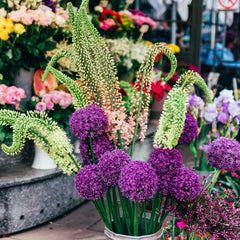
Allium & Eremurus - Spheres & Spires Blend
$17.95
Contains: 1 pack of 20 Allium Purple Sensation bulbs and 1 pack of 3 Eremurus Cleopatra divisions
Botanical Name: Allium and Eremurus
Exposure: Full Sun
Hardiness: Zones 6-10

Allium - Oreophilum
$5.95
Contains: 20 Allium bulbs
Botanical Name: Allium oreophilum, syn Allium ostrowskianum, syn. Allium platystemon
Exposure: Full Sun
Hardiness: Zones 4-9

Allium - Schubertii
$7.95
Contains: 3 Allium bulbs
Botanical Name: Allium schubertii
Exposure: Full Sun
Hardiness: Zones 4-10

Allium - Silver Spring
$9.95
Contains: 3 Allium bulbs
Botanical Name: Allium multibulbosum 'Silver Spring'
Exposure: Full Sun
Hardiness: Zones 4-9

Allium - Amplectens Graceful Beauty
$9.95
Contains: 20 Allium bulbs
Botanical Name: Allium amplectens 'Graceful Beauty'
Exposure: Full Sun
Hardiness: Zones 4-9
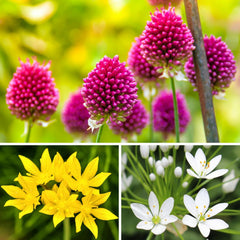
Allium - Garden Sprinkles Collection
$14.95
Contains: 20 Allium bulbs each of: Purple Drumstick, White, and Yellow
Botanical Name: Allium
Exposure: Full Sun
Hardiness: Zones 7-9

Allium - Moly Golden Garlic
$5.95
Contains: 20 Allium bulbs
Botanical Name: Allium moly
Exposure: Full Sun
Hardiness: Zones 3-9

Allium - Mount Everest
$12.95
Contains: 3 Allium bulbs
Botanical Name: Allium stipitatum 'Mount Everest'
Exposure: Full Sun
Hardiness: Zones 4-8

Allium - Roseum Rosy Garlic
$5.95
Contains: 20 Allium bulbs
Botanical Name: Allium roseum
Exposure: Full Sun
Hardiness: Zones 6-9

Allium - Bulgaricum
$5.95
Contains: 20 Allium bulbs
Botanical Name: Allium siculum, syn. Nectaroscordum siculum
Exposure: Full Sun
Hardiness: Zones 5-10

Allium - Summer Sparkler Mix
$14.95
Contains: 60 Allium bulbs mixed
Botanical Name: Allium
Exposure: Full Sun
Hardiness: Zones 7-9

Allium - Vineale Dready
$4.95
Contains: 20 Allium bulbs
Botanical Name: Allium vineale 'Dready'
Exposure: Full Sun
Hardiness: Zones 4-9

Allium - Sonoma Collection
$19.95
Contains: 20 Allium bulbs each of: White and Deep Purple
Botanical Name: Allium
Exposure: Full Sun
Hardiness: Zones 4-8

Allium - Christophii Star of Persia
$8.95
Contains: 20 Allium bulbs
Botanical Name: Allium christophii (albopilosum)
Exposure: Full Sun
Hardiness: Zones 5-8
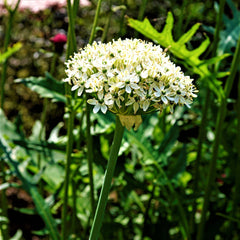
Allium - Nigrum
$14.95
Contains: 20 Allium bulbs
Botanical Name: Allium nigrum
Exposure: Full Sun
Hardiness: Zones 4-9

Allium - Playful Party Mix
$8.95
Contains: 60 Allium bulbs mixed
Botanical Name: Allium
Exposure: Full Sun
Hardiness: Zones 7-9

Allium - Azureum Blue of the Heavens
$9.95
Contains: 20 Allium bulbs
Botanical Name: Allium caeruleum
Exposure: Full Sun
Hardiness: Zones 4-10

Allium - Atropurpureum
$12.95
Contains: 20 Allium atropurpureum bulbs
Botanical Name: Allium atropurpureum
Exposure: Full Sun
Hardiness: Zones 4-7
Where to Plant
Alliums thrive in locations with rich, well-drained soil and full sun but will tolerate partial shade. If you notice water puddles 5–6 hours after a hard rain, you'll want to find another site or amend the soil with the addition of organic material to improve drainage. Alliums aren't fussy about soil, but they will not survive in soggy conditions or standing water. If using containers, make sure there are adequate drainage holes and keep in mind the mature size of the varieties you have chosen to plan your container sizes accordingly.
When to Plant
Allium bulbs are typically planted when dormant in the fall. While they are remarkably resilient in a dormant state and will tolerate waiting, they should be planted a few weeks before the ground freezes. After planting, their roots will form, and you can expect blooms to arrive in late spring or early summer.
How to Plant
- Find a location where your Alliums will receive full sun, as they develop stronger stems in brighter light.
- Fill containers, if you're using them, with good quality, well-drained soil. Almost any commercially available potting medium will do the trick.
- Dig holes and bury the bulbs 4–8" deep and 6"–8" apart with the pointy end facing up.
- Water thoroughly after planting to settle the soil around the bulbs.
How to Grow
- Water as needed during active growth, aiming for about 1" of moisture per week.
- Stake taller Alliums to avoid breakage. Shorter varieties don’t require staking.
- Leave the foliage in place after blooms have faded. The leaves will gather sunlight to create food through photosynthesis, strengthening the bulb for the future.
- Remove the foliage in mid-summer when the leaves turn yellow and die back as the plant slips into dormancy. This clean-up will give your Allium a clean slate before beginning the next growing cycle.
Allium Tips & Tricks
- Snip a few of these brilliant blooms during the growth period for striking arrangements or for drying. Don’t worry—this won’t hurt your plants!
- Expect the most substantial top growth and flower stems to arrive in the spring. Those in warmer climates may also develop a few sprouts in autumn.
- Amend soil with compost, ground bark, or decomposed manure as needed to avoid water-logging your plant.
- Plant a clump of Allium bulbs for magnificent clusters of blooms rather than a stand-alone display.

